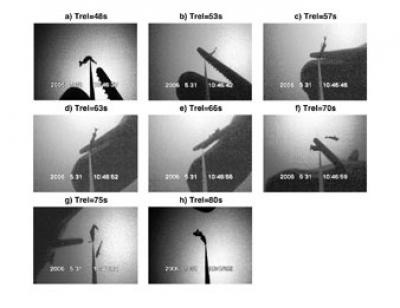Caught on Video: Whales Steal Fish

Sneaky sperm whales had been snagging an easy meal by stealing black cod from deep-sea fishing lines off Sitka, Alaska. Now, underwater video has revealed their cod-thieving secret: The giant marine mammals pluck the fishing line at one end to shake the black cod free at the other end.
The video results also shed light on the link between the whale's size and the kind of clicking sounds it emits.
Sperm whales (Physeter macrocephalus), which are the largest of the toothed whales, echolocate to pinpoint their prey. Basically, they emit clicking sounds that bounce off potential meals, including large squid and other fish. Scientists think an organ inside the animal's massive head (which can take up 25 to 35 percent of its body length) plays a role in transmitting the clicks.
And so scientists had thought the sounds emitted by sperm whales might contain information about the animals' size. But the whales typically forage in deep waters spanning 984 to 6,500 feet (300 to 2,000 meters), making it difficult for scientists to capture the feeding whales on video.
An opportunity arose off Sitka, Alaska, where the sperm whales were gathering at shallower depths to thieve black cod from longlines, or deep-sea fishing gear with a main fishing line draped across the ocean and fastened with shorter lines bearing baited hooks.
Delphine Mathias and Aaron Thode of Scripps Institution of Oceanography, and their colleagues, deployed acoustic recorders and video cameras on longlines in 2004 and 2006, respectively.
In addition to spying the burglars, the scientists matched the size of each whale's head with its acoustic signal. The collected data also helped scientists to infer the size of the whale's spermaceti organ, which produces a white, waxy substance previously used in candles and ointments, as well as the so-called "junk" inside the whale's head. That junk likely plays a role in transmitting sound from the whale's head.
Sign up for the Live Science daily newsletter now
Get the world’s most fascinating discoveries delivered straight to your inbox.
"The sounds can be louder than a firecracker," Thode said. "But until this video recording was made, scientists had not been able to get a direct measurement of the size of the animal and the foraging sounds at the same time."
The study, which is detailed in the May issue of the Journal of the Acoustical Society of America, could be a first step in the broader use of acoustics to survey whale populations as supplements to visual counts of the animals.
The research was supported by the National Geographic Society and North Pacific Research Board.
{{ video="LS_090526_Whales-Steal-Fish" title="Whales Steal Fish" caption="Sperm whales pluck fish from a line as if shaking apples from a tree." }}
- Video – Whales Steal Fish
- Whale News, Images and Information
- Images: Rich Life Under the Sea
Jeanna Bryner is managing editor of Scientific American. Previously she was editor in chief of Live Science and, prior to that, an editor at Scholastic's Science World magazine. Bryner has an English degree from Salisbury University, a master's degree in biogeochemistry and environmental sciences from the University of Maryland and a graduate science journalism degree from New York University. She has worked as a biologist in Florida, where she monitored wetlands and did field surveys for endangered species, including the gorgeous Florida Scrub Jay. She also received an ocean sciences journalism fellowship from the Woods Hole Oceanographic Institution. She is a firm believer that science is for everyone and that just about everything can be viewed through the lens of science.










